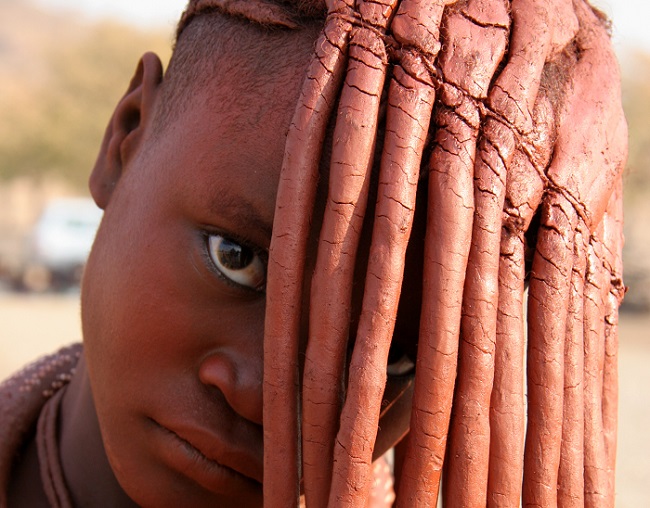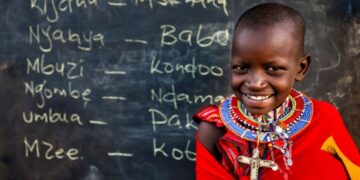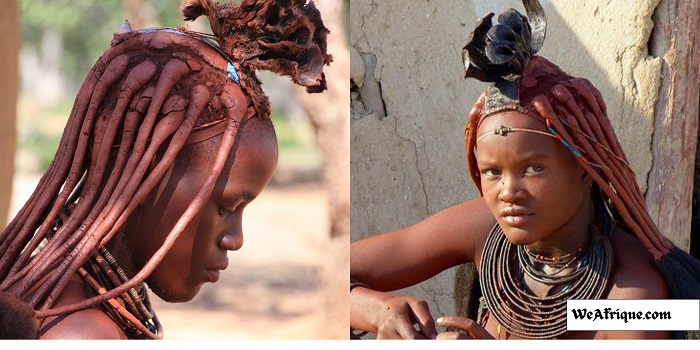- The Himba women are known for their unique skin color which is gotten from a red paste/powder called ‘otjize’
- Once a Himba girl reaches puberty, she is subjected to marrying any male suitor considered suitable by her father
- Although a Himba woman marries early, she is only considered a full-fledged woman when she starts bearing children
The Himba Women of northern Namibia are famous for their use of ‘otjize'(a red paste of butter, fat, and red ochre) on their skin as a way of maintaining their beauty. Aside from their unique hairstyle, the women adorn themselves with handmade jewelry. Their looks have been described as iconic images portraying African culture.
A well-known fact about the Himba women is that they are forbidden to use water, that’s to say, they do not bathe nor wash with water. Despite western influences, the Himba people have retained their traditions and culture.
Origin of the Himba People
Generally, the Himba tribe is a nomadic tribe that is located in central and West Africa. However, they are now settled in Angola and Namibia. Also known as the OvaHimba, they are regarded as the last semi-nomadic people of Namibia.
Traditionally, Himba women and girls are known to be hardworking. They perform more labor-intensive work like making handicrafts and milking cows and goats. Their male counterparts usually tend to cattle which sometimes results in them leaving their homes for a long period of time.
Marriage Rites and Childbirth
Himba men are polygamous so a husband can have two wives at the same time. However, the tradition says that the wives are usually chosen by the first wife’s father. Also, they practice early arranged marriages where young Himba girls are made to marry male suitors chosen by their fathers.
This happens once the girls reach puberty. Hence girls from 10 years can be married off but the practice is illegal in the country.
For Himba boys, it is customary to be circumcised before puberty. Then upon getting married, the boy is considered a man. Meanwhile, a Himba girl is not considered a fully-fledged woman until she bears a child.
Before marriage, a bride price must be paid for a Himba woman, just as it is with most tribes in Africa. Also called bridewealth, it is only accepted by the bride’s family if the value of the cattle. Offering an Ox as bridewealth is the standard practice but cattle is given if the groom’s father is wealthy.
Himba Birth Song: Myth or Fact
There are several speculations regarding the Himba birth song. A comment on reddit.com claims that when a Himba woman decides to have a child, she sits under a tree alone so she can listen to the song of the child who wants to come.
After listening to the song, she goes back to her husband and teaches him the song before they make love to conceive the child. As a way of inviting the child, the couple sings the song during lovemaking.
When the woman becomes pregnant, she then teaches the child’s song to the midwives and other old women of the village so that when the child is born, the old women and the people would gather around and sing the song to welcome the child.
The song remains with the person till death. However, there are claims that the Himba song is just a myth.
Read Also: Naked Tribe – You Will Not Believe That These 5 Tribes Are Still Walking Naked
Traditional Clothing and Hairstyle

Due to the semi-arid climate of the Himba tribe’s homestead, both the men and women wear traditional clothes that befit their environment. Most times, the people wear a skirt-like piece made from calfskin and sheepskin.
For their footwear, the women wear shoes that are made from cow’s skin. They also wear ankle bracelets which have vertical lines that represent the number of children the woman wearing them has.
Women who have children wear a backpack made of skin on their clothing. Also, they cover themselves with ‘otjize’ paste, which is believed to cleanse their skin. The red mixture also protects their skin from the hot and dry climate as well as insect bites.
Traditional, the ‘otjize’ paste is seen as an aesthetic beauty cosmetic that symbolizes the earth’s rich red color and blood.
For the OvaHimba, hair symbolizes growth and maturity. As for their hairstyles, the girls have many otjize-textured hair plaits that are arranged to fall on the girl’s face, the plaits are often tied together and parted back from the face.
Women who have been married for about a year and have a child wear an ornate headpiece called the ‘Erembe’. Their male counterpart has to wear a braid from a young age. Once they get married, they wear a cap to show that they are married so their hair cannot be too exposed. A widower in the Himba tribe, remove the cap and expose their unbraided hair.
Himba Women Bath in Smoke
According to reports, only Himba men had access to water in the past. This dates back to the time when the Himba community suffered great droughts.
Hence the women reportedly do not use water, they use wood ash for hair cleansing. Also, they bathe in smoke daily to maintain personal hygiene. The smoke is from a bowl of herbs and charcoal. For a full-body wash, the women cover themselves with a thick cloth in other to trap the smoke underneath it.
Matriclan Inheritance
Inheritance of wealth in the Himba culture is determined through the matriclan. The male son does not inherit his father’s wealth but rather his maternal uncle’s.
It is general knowledge that in Africa, the Himba people are secluded from western influences. However, they have unique ways of doing things. The women are known to be very beautiful and hardworking. Himba women are also well known for their use of otjize on the skin and hair which is a way of maintaining their beauty. However, would the Himba women be able to adapt to the modern world and still maintain their culture? Letting go of some of their traditional lifestyle might ensure a bright future for their children.





















Discussion about this post